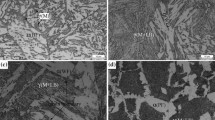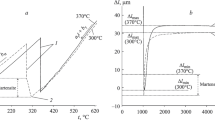Abstract
The unique two-stage dilatation curve observed during the inverse bainite transformation of a hypereutectoid low alloy steel is analyzed to understand the transformation kinetics. A new algorithm is proposed to extract the bainitic phase fractions from the raw dilatometry data. The proposed data extraction algorithm is generic that relies only on the density of phases involved in the transformation. To verify the extracted phase fraction, a kinetics model is developed using the principles of diffusion and Johnson–Mehl–Avrami–Kolmogorov kinetics. The predicted phase fractions by the kinetics model agree fairly well with the experimental phase fraction results from dilatometry, metallography, and XRD. The two-stage transformation can be explained by the kinetics of inverse bainite as a diffusion-controlled transformation product. The transformation proceeds in a para-equilibrium mode, involving only the diffusion of carbon at the inverse bainite/parent austenite interface








Similar content being viewed by others
References
Liu Y, Wang D, Sommer F, Mittemeijer EJ (2008) Isothermal austenite-ferrite transformation of Fe-0.04 at.% C alloy: Dilatometric measurement and kinetic analysis. Acta Mater 56(15):3833–3842
Militzer M, Mecozzi MG, Sietsma J, van der Zwaag S (2006) Three-dimensional phase field modelling of the austenite-to-ferrite transformation. Acta Mater 54(15):3961–3972
Kolmogorov A (1937) A statistical theory for the recrystallization of metals. Izv Akad Nauk SSSR 1(10):355–359
Johnson W, Mehl R (1939) Reaction kinetics in processes of nucleation and growth. Trans AIME 135(10):416–442
Avrami M (1939) Kinetics of phase change. I general theory. J Chem Phys 7(12):1103–1112
Avrami M (1940) Kinetics of phase change. II transformation-time relations for random distribution of nuclei. J Chem Phys 8(2):212–224
Christian J (2002) Formal theory of transformation kinetics, chap 12. In: The theory of transformations in metals and alloys, pp 529–552. https://doi.org/10.1016/B978-008044019-4/50016-7
Zener C (1949) Theory of growth of spherical precipitates from solid solution. J Appl Phys 20(10):950–953
Bos C, Sietsma J (2007) A mixed-mode model for partitioning phase transformations. Scr Mater 57(12):1085–1088
Sietsma J, Van Der Zwaag S (2004) A concise model for mixed-mode phase transformations in the solid state. Acta Mater 52(14):4143–4152
Gavard L, Bhadeshia HKDH, MacKay DJC, Suzuki S (1996) Bayesian neural network model for austenite formation in steels. Mater Sci Technol 12(6):453–463
Speyer RF (1994) Thermal analysis of materials. CRC Press, Boca Raton
Garcia de Andres C, Caballero F, Capdevila C, Alvarez L (2002) Application of dilatometric analysis to the study of solid–solid phase transformations in steels. Mater Charact 48(1):101–111
Garcia de Andres C, Caballero F, Capdevila C (1998) Dilatometric characterization of pearlite dissolution in 0.1C–0.5Mn low carbon low manganese steel. Scr Mater 38(12):1835–1842
ASTM A1033-04. A1033-04, Standard practice for quantitative measurement and reporting of hypoeutectoid carbon and low-alloy steel phase transformations. ASTM Standards 2004 4(Reapproved 2015):1–14
Kamyabi-Gol A, Clark SJ, Gibbs JW, Sridhar S, Mendez PF (2016) Quantification of evolution of multiple simultaneous phase transformations using dilation curve analysis (DCA). Acta Mater 102:231–240
Onink M, Tichelaar FD, Brakman CM, Mittemeijer E, van der Zwaag S (1996) Quantitative Analysis of the dilation by decomposition of Fe–C autenites, calcualtion of volume change upon transformation. Z Metallkd 87:24–32
Oh CS, Han HN, Lee CG, Lee TH, Kim SJ (2004) Dilatometric analysis on phase transformations of intercritical annealing of Fe–Mn–Si and Fe–Mn–Si–Cu low carbon TRIP steels. Met Mater Int 10(5):399–406
Zhao J, Mesplont C, De Cooman B (2002) Quantitative analysis of the dilatation during an isothermal decomposition of austenites. Mater Sci Eng A 332(1–2):110–116
Scott C, Drillet J (2007) A study of the carbon distribution in retained austenite. Scr Mater 56(6):489–492
Clarke A, Speer J, Miller M, Hackenberg R, Edmonds D, Matlock DK, Rizzo FC, Clarke KD, De Moor E (2008) Carbon partitioning to austenite from martensite or bainite during the quench and partition (Q&P) process: a critical assessment. Acta Mater 56(1):16–22
Zhang MX, Kelly P (1998) Determination of carbon content in bainitic ferrite and carbon distribution in austenite by using CBKLDP. Mater Charact 40(3):159–168
Krauss G (2015) Steels processing, structure, and performance, 2nd edn. ASM International, Materials Park, pp 99–112
Bhadeshia HKDH (2001) Bainite in steels, transformations, microstructure and properties, 2nd edn. IOM Communications Ltd., London, pp 277–284
Hillert M (1957) The role of interfacial energy during solid state phase transformations. Jernkont Ann 141:757–789
Kannan R, Wang Y, Li L (2017) Identification of inverse bainite in Fe-0. 84 C-1 Cr-1 Mn hypereutectoid low alloy steel. Metall Mater Trans A 48(3):948–952
Doebelin N, Kleeberg R (2015) Profex: a graphical user interface for the Rietveld refinement program BGMN. J Appl Crystallogr 48(5):1573–1580
Schneider CA, Rasband WS, Eliceiri KW (2012) NIH image to ImageJ: 25 years of image analysis. Nat Methods 9(7):671–675
Onink M, Brakman CM, Tichelaar FD, Mittemeijer E, van der Zwaag S, Root JH, Konyer NB (1993) The lattice parameter of austenite and ferrite in Fe–C alloys as function of carbon concentration and temperature. Scr Metall Mater 29:1011–1016
Chae J, Jang J, Zhang G, Kim K, Lee J, Bhadeshia HKDH, Suh DW (2011) Dilatometric analysis of cementite dissolution in hypereutectoid steels containing Cr. Scr Mater 65(3):245–248
Jablonka A, Harste K, Schwerdtfeger K (1991) Thermomechanical properties of iron and iron–carbon alloys: density and thermal contraction. Steel Res 62(1):24–33
Caballero FG, Capdevila C, De Andres CG (2002) Modelling of kinetics and dilatometric behaviour of austenite formation in a low-carbon steel with a ferrite plus pearlite initial microstructure. J Mater Sci 37(16):3533–3540. https://doi.org/10.1023/A:1016579510723
Bhadeshia HKDH (1982) Thermodynamic analysis of isothermal transformation diagrams. Metal Sci 16(3):159–166
Liu F, Sommer F, Bos C, Mittemeijer EJ (2007) Analysis of solid state phase transformation kinetics: models and recipes. Int Mater Rev 52(4):193–212
Van der Ven A, Delaey L (1996) Models for precipitate growth during the γ → α + γ transformation in Fe–C and Fe–C–M alloys. Prog Mater Sci 40(3):181–264
Andersson JO, Helander T, Hoglund L, Shi P, Sundman B (2002) Thermo-Calc & DICTRA, computational tools for materials science. Calphad 26(2):273–312
Bhadeshia H, David SA, Vitek JM, Reed RW (1991) Stress induced transformation to bainite in Fe–Cr–Mo–C pressure vessel steel. Mater Sci Technol 7:686–698
Takahashi M (1992) Reaustenitisation from bainite in steels. Ph.D. thesis, University of Cambridge
Stuart H, Rindley N (1966) Thermal expansion of cementite and other phases. J Iron Steel Inst 204:711–717
Kannan R, Wang Y, Li L (2017) Microstructural evolution of inverse bainite in a hypereutectoid low alloy steel. Metall Mater Trans A. https://doi.org/10.1007/s11661-017-4373-6
Garcia-Mateo C, Caballero F, Capdevila C, de Andres CG (2009) Estimation of dislocation density in bainitic microstructures using high-resolution dilatometry. Scr Mater 61(9):855–858
Wang J, van der Wolk PJ, van der Zwagg S (2000) On the influence of alloying elements on the bainite reaction in low alloy steels during continuous cooling. J Mater Sci 35:4393–4404. https://doi.org/10.1023/A:1004865209116
Chen H, van der Zwagg S (2014) Predicting the effect of Mo, Ni, and Si on the bainitic stasis. Metall Mater Trans A 45A:3429–3437
Chen H, Borgenstam A, Odqvist J, Zuazo I, Goune M, Agren J, van der Zwagg S (2013) Application of interrupted cooling experiments to study the mechanism of bainitic ferrite formation in steels. Acta Mater 61:4512–4523
Ranganathan S, Von Heimendahl M (1981) The three activation energies with isothermal transformations: applications to metallic glasses. J Mater Sci 16(9):2401–2404. https://doi.org/10.1007/BF01113575
Author information
Authors and Affiliations
Corresponding author
Ethics declarations
Conflict of interest
The authors declare that they have no conflict of interest.
Appendix
Appendix
Detailed derivation of Eq. 4 in “Algorithm to extract phase fraction from raw dilatometry data” section
Equation 3 is with the assumption that density of cementite and hence \( \lambda_{\theta } \) does not vary with carbon concentration. In Eq. 3, the ratio of sample density to the density of austenite is taken as \( \lambda_{\gamma } \) \( \left( {\lambda_{\gamma } = \frac{{\rho_{o} }}{{\rho_{{\gamma \left( {T,C} \right)}} }}} \right) \).
Jablonka [31] fitted the variation in density of austenite with carbon content at constant temperature and found that the density of austenite varies linearly with carbon content. The density function of austenite at constant temperature is given by
Substituting Eqs. 32 and 33 in Eq. 31,
Substituting Eq. 34 in Eq. 3, the volume change rate can now be described by the following differential equation,
The second term on the right-hand side in the above equation is negligible and is assumed zero because the fraction of cementite that nucleates and grows at the start of transformation is small, and the rate of change in fraction of cementite formed is also small. The justification for the approximation is given in “Error caused by the approximations used in the derivation of the algorithm” section. Therefore, Eq. 35 can be simplified as
Writing mass balance with respect to carbon,
Substituting Eq. 37 in Eq. 36,
The term \( \left[ {1 - 0.0146\left( {\frac{{0.84 - 6.67f_{\theta } }}{{1 - f_{\theta } }}} \right)} \right]^{2} \) is approximately equal to 1. The error caused by making this assumption is given in “Error caused by the approximations used in the derivation of the algorithm” section. Therefore, Eq. 38 can be simplified as
which leaves an Euler-type integration scheme as below,
that calculates the fraction of cementite as a function of dilatation obtained from raw dilatometry data.
where
Error caused by the approximations used in the derivation of the algorithm
During the derivation of phase fraction of cementite, in Eq. 35, it is assumed that the contribution by term \( \frac{{\partial f_{\theta } }}{\partial t}\rho_{o} \left[ {\frac{{\rho_{{\gamma \left( {T,C} \right)}} - \rho_{\theta } }}{{\rho_{{\gamma \left( {T,C} \right)}} \rho_{\theta } }}} \right] \) to the phase fraction calculation is negligible. Once, the phase fraction were calculated, the value of the term \( \frac{{\partial f_{\theta } }}{\partial t}\rho_{o} \left[ {\frac{{\rho_{{\gamma \left( {T,C} \right)}} - \rho_{\theta } }}{{\rho_{{\gamma \left( {T,C} \right)}} \rho_{\theta } }}} \right] \) was determined to be 2 × \( 10^{ - 6} \). Error is calculated in the 7-min isothermal hold sample by accounting this term into phase fraction calculation, and it was found that the average error caused by not accounting this term is 7.6 × \( 10^{ - 6} \), i.e., 0.076%. The error caused is negligible, and therefore the approximation is valid. During the derivation of phase fraction of cementite, in Eq. 38, it is assumed that the term \( \left[ {1 - 0.0146\left( {\frac{{0.84 - 6.67f_{\theta } }}{{1 - f_{\theta } }}} \right)} \right]^{2} \) is close to unity. Once, the phase fraction was calculated, the value of the term \( \left[ {1 - 0.0146\left( {\frac{{0.84 - 6.67f_{\theta } }}{{1 - f_{\theta } }}} \right)} \right]^{2} \) was calculated and the average value was found to be 0.97653. Error in the phase fraction is calculated by accounting this term, and the absolute average error caused by the approximation is 6.13 × \( 10^{ - 4} \), i.e., 0.061%, which is negligible. Therefore, the approximation is justified.
Rights and permissions
About this article
Cite this article
Kannan, R., Wang, Y. & Li, L. A dilatometric analysis of inverse bainite transformation. J Mater Sci 53, 3692–3708 (2018). https://doi.org/10.1007/s10853-017-1752-8
Received:
Accepted:
Published:
Issue Date:
DOI: https://doi.org/10.1007/s10853-017-1752-8




